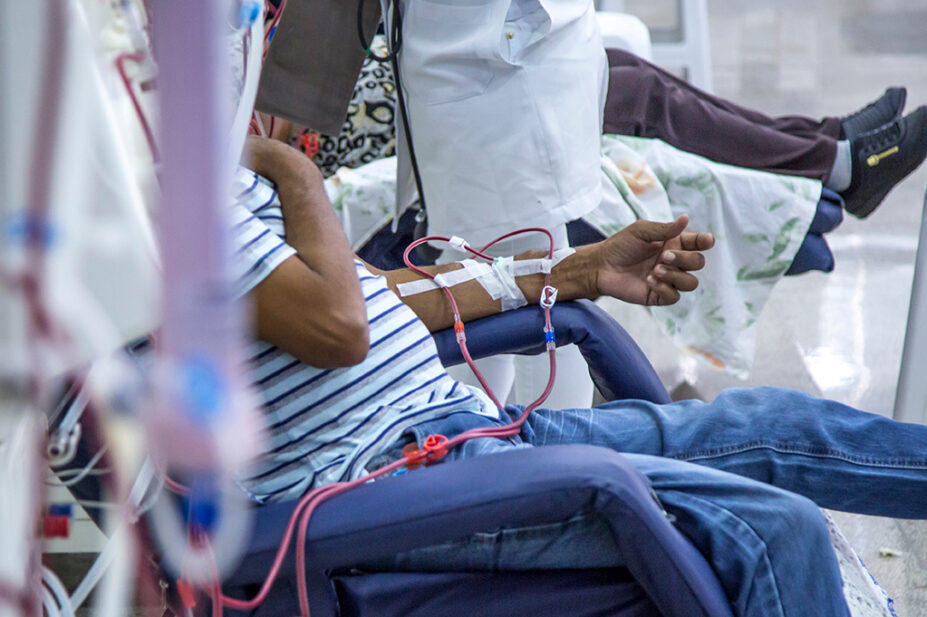
Shutterstock.com
After reading this article, you should be able to:
- Recognise the limitations of creatinine and creatinine-based calculations in acute kidney injury;
- Differentiate between chronic and acute kidney impairment;
- Understand the changes in pharmacokinetics/pharmacodynamics in patients with acute kidney injury, chronic kidney disease and those receiving dialysis;
- Recognise the need for dose reductions of antimicrobials in patients with renal impairment.
Caution should be exercised when prescribing medication in patients with renal impairment, owing to the risk of drug accumulation, poorly tolerated adverse effects and impaired efficacy[1]. These effects can generally be mitigated by adjusting the dose or increasing the dosing interval.
This is the second article in a two-part series outlining the importance of antimicrobial dosing in patients with organ dysfunction. The second part focuses on antimicrobial dosing in patients with acute kidney injury (AKI), chronic kidney disease (CKD) and patients on dialysis.
Additional information on antimicrobial resistance and principles guiding dose adjustments can be found in part one of this series.
Renal function calculations
A patient’s renal function is routinely reported using estimated glomerular filtration rate (eGFR) or creatinine clearance (CrCl) calculations, both of which rely on the measurement of serum creatinine (SCr)[1].
The CrCl calculation considers different age groups, genders and body weight as factors that can affect renal function; however, it does not account for variations between different ethnicities and inaccuracies have been seen in extremes of body weight or muscle mass[2]. CrCl does adjust for body weight and is widely used for drug dosing adjustment in product licences and by clinical resources (such as the BNF).
CrCl should be used when renal function is stable and tends to be inaccurate at low GFR because of increased renal tubular secretion of creatinine[2]. CrCl values should not be used in patients with end-stage renal disease and those on renal replacement therapy[2].
eGFR does not consider differences in body surface area (BSA) and assumes all patients have a BSA of 1.73m2. Therefore, eGFR may overestimate renal function in patients with reduced BSA and underestimate renal function in patients with a larger BSA[2].
Most clinical laboratories will report the parameters of urea, serum creatinine and eGFR, while pharmacists will calculate CrCl to establish kidney function taking into account age, gender and weight[1]. The two values are not interchangeable (although for most adults with average weight and height eGFR may be used)[1]. For patients at extremes of body weight/muscle mass, older patients, those with deteriorating organ function and those on narrow therapeutic index medicines (e.g. gentamicin, vancomycin), pharmacists are advised to use CrCl to estimate renal function and should consider the implications of overdosing and underdosing for patients whose calculated GFR varies according to the formula used[1,2].
Creatinine-based calculations assume steady-state conditions and should only be used for interpreting renal function in chronic renal diseases. Owing to the delay in SCr response to kidney function (48 to 72 hours), both eGFR and CrCl estimates are not validated in acute kidney injury (AKI). Urine output and/or urine excretion calculations (over 6 to 24 hours, 6 hours is the minimum required to diagnose an AKI as per NICE; 24 hours would give a more accurate picture) provide more accurate measures of renal function during dynamic changes[1,3]. Pharmacists should be confident when differentiating between acute and chronic kidney impairment before recommending dose adjustments.
Acute kidney injury
AKI is defined as an acute decline in renal function leading to an increase in SCr and/or a fall in urine output[4]. AKI describes a spectrum of kidney injury ranging from mild impairment to renal failure, comprising both direct injury to the kidney and a reduction in functionality. AKI is a broad clinical syndrome encompassing a range of etiologies including hypo-perfusion (pre-renal), urine outflow obstruction (post-renal) and intrinsic kidney damage owing to kidney disease or exposure to nephrotoxins. It is diagnosed when one of the following criteria is met:
- Rise in serum SCr of 26 micromol/L or greater within 48 hours;
- A 50% or greater rise in SCr within the past 7 days;
- A fall in urine output to less than 0.5mL/kg/hour for >6 hours[5,6].
Antimicrobial dosing can be considerably influenced by a patient’s renal function. Specific dose reductions of antimicrobials eliminated via the kidneys (e.g. β-lactams and aminoglycosides) are frequently determined by the manufacturer and are often intended for use in patients with stable CKD; for example, increasing the dosing interval of meropenem when patients have a CrCl of <50ml/min. These dose adjustments are established in early-phase studies that enrol a small number of patients with CKD and may not be applicable to episodic use in the dynamic context of AKI[7,8].
AKI is a common complication in patients presenting with systemic infections, including sepsis[9]. Hypovolaemia (i.e. decreased blood volume) and subsequent decreased kidney perfusion in sepsis precipitates AKI, prompt and effective antimicrobial treatment is imperative to optimise patient outcomes[7]. Antimicrobial selection and dosing in patients with sepsis-induced AKI poses a difficult clinical paradigm as prescribers aim to reduce the risk of drug toxicity without compromising on efficacy.
Changes in PK during sepsis result can influence the PD of antimicrobials. Drug absorption from the gastrointestinal tract is decreased in hemodynamically compromised patients, meaning IV administration is preferred. There is an increased volume of distribution (Vd), owing to aggressive fluid resuscitation in response to hypotension.
Decreased levels of albumin is seen in critically unwell patients, which can further increase the Vd and reduce protein binding, resulting in decreased plasma drug concentration and the negation of treatment efficacy of hydrophilic antimicrobials, such as β-lactams, aminoglycosides and glycopeptides[10]. Additional information on how critical illness can impact drug pharmacokinetics and pharmacodynamics can be found here.
Premature dose reductions determined by calculations that rely on SCr carry the risk of missed therapeutic opportunity owing to the time lag between the initial cause of the injury and diagnosis. Inappropriate empirical dose reductions in the setting of AKI can decrease the clinical response in patients with renal impairment. When the biochemical profile of SCr, the importance of antimicrobial therapy in the acute phase and data that suggest >50% of sepsis-induced AKIs resolve within 48 hours are all considered, deferring dose adjustments of antimicrobials with a wide therapeutic index (e.g. β-lactams) by 48 hours can ensure adequate therapy and allow time for renal function to be estimated accurately[7,10,11].
Aminoglycosides, such as gentamicin and amikacin, are often avoided during AKI owing to their known nephrotoxic profile; however, a single dose can be utilised in patients that present with infective symptoms owing to its efficacy against Gram-negative pathogens such as E.coli and Klebsiella spp. that are commonly implicated in urinary and gastrointestinal bacterial infections. Repeated doses of aminoglycosides are not always recommended owing to the risk of toxicity with persistently high serum levels.
Use of trimethoprim (either alone or with sulfamethoxazole) can obscure SCr monitoring, owing to its known interference with tubular secretion of creatinine[12]. Fluoroquinolones are lipophilic compounds with a large Vd and therefore dose reductions in the first 48 hours are not always necessary[11]. A review of dosing after 48 hours is recommended and dose reductions advised if there is no recovery of renal function post-AKI. Agents with known nephrotoxicity potential (e.g. gentamicin, amikacin, vancomycin) should be prescribed with caution and alternative treatments with non-renal clearance (e.g. doxycycline, clindamycin, linezolid) recommended where possible. If treatment is unavoidable, therapeutic drug monitoring (TDM) to personalise antimicrobial therapy in patients with AKI is advised; however, this is usually limited to aminoglycosides and vancomycin in the hospital setting.
Chronic kidney disease
CKD is defined as a reduction in kidney function or structural kidney damage that is present for a period greater than 3 months[13,14]. Patients with CKD often have multiple comorbidities and require multiple concomitant medications. There are inherent risks associated when prescribing for this population group, owing to the prolonged half-lives and reduced clearance of renally excreted compounds and their metabolites, leading to higher incidences of adverse events[14,15]. For example, ototoxicity (i.e. damage to the ear resulting in hearing or balance issues) can occur from accumulation of aminoglycosides and vancomycin, while excess β-lactam antibiotics can penetrate the CNS causing seizures. An increased Vd owing to fluid overload and pathological alterations in protein binding can also alter pharmacokinetics in CKD. This necessitates the careful selection and dose consideration of medications to optimise the risk: benefit ratio[15,16].
Patients with CKD have higher incidences of hospitalisation, longer hospital stays, and compounding risk factors for infection, such as uraemia, anaemia, malnutrition, immunosuppressive therapy and frequent vascular access[15]. Infections are a significant cause of morbidity and mortality in this patient group, making appropriate antimicrobial selection imperative[17].
Antimicrobials, such as nitrofurantoin, require good renal function to reach the site of infection; therapeutic failure is common in CKD patients treated with nitrofurantoin for this indication and it is best avoided in this cohort. The Renal Drug Database is a comprehensive resource for prescribers and pharmacists with practical information relating to medication use in patients with CKD[18]. Where possible, antimicrobial therapies such as linezolid, tigecycline and clindamycin that are non-nephrotoxic may be preferred in patients with CKD where indicated.
Dose adjustments are recommended for antimicrobials with high renal clearance. Achieving concentrations within effective, non-toxic ranges is the main goal of dosing antimicrobials in CKD, the following points can be considered:
- Loading doses may be required if there is a need to rapidly achieve steady-state concentration owing to the changes in Vd;
- Reducing the maintenance dosing or increasing the time between dosing intervals can be used for time-dependent antimicrobials, such as β-lactams;
- Therapeutic drug monitoring of antimicrobials can be used to optimise regimens in patients with CKD to ensure safe and efficacious levels. Serum levels of aminoglycosides and glycopeptides should be used to confirm adequate clearance of the drug before re-dosing[17,19].
Patients on dialysis
Haemodialysis (HD) is a form of intermittent renal replacement therapy; the dialyser machine acts as an artificial kidney, filtering the blood to remove urea, toxins and drugs. Patients often receive HD three times a week and for up to four hours per session; however, the HD schedule will be individualised for the patient. Consequently, patients will experience good drug clearance on dialysis days but not during the interdialytic period[20]. Pharmacists must assess the impact of HD on drug therapy by considering the following factors:
The clinical situation in which dialysis is performed
Pharmacists must always consider the clinical context when using antimicrobials in patients receiving HD (i.e. if the patient is acutely unwell or clinically stable). In situations of acute deterioration or sepsis, achieving therapeutic dosing of antibacterials is of great importance[15].
The dialysis schedule and prescription
Pharmacists must confirm the HD days with either the patient or the dialysis unit. It is important to note that HD days are often set by the renal team and are unlikely to be changed to suit drug dosing. Quite commonly, drug dosing must work around the HD schedule and is often given after the dialysis session to maximise therapeutic drug levels until the next session[15].
It is important to understand the dialysis prescription, which contains the following information:
- Type of membrane used (e.g. high flux or low flux; where high flux refers to a more permeable membrane and facilitates removal of middle and small solutes): high flux membranes are more porous and thus have a greater propensity to remove small antimicrobial drug molecules from the blood and result in sub-optimal therapy; therefore, higher doses may be required for high flux machines;
- Duration of the session: prolonged HD sessions result in greater removal of antimicrobial drug from the patient’s blood;
- Target dry weight: described as the post-dialysis weight of the patient at which the blood pressure remains normal during the interdialytic period. Administering intravenous antimicrobials in high volumes of diluent will inadvertently result in excess fluid in the interdialytic period (e.g. co-trimoxazole);
- Medication given during dialysis sessions (e.g. erythropoietin and iron) should be reviewed for interactions[9,20,21].
Drug characteristics
The following characteristics of the antibacterial drug to be administered should be considered:
- Molecular size of the drug: smaller and middle-size antimicrobial molecules (e.g. amoxicillin) are more likely to be dialysed out during the session, which may result in sub-optimal therapy when compared with larger molecules (e.g. teicoplanin);
- Degree of protein binding: only un-bound drugs (or ‘free-fraction’) will dialyse out of the blood in a HD session. Therefore, highly protein-bound antimicrobials such as ceftriaxone are less likely to be dialysed out or removed during a HD session, which results in more consistent therapy. However, in patients with a low serum albumin, there is less albumin to bind to the drug and consequently a greater fraction of drug exists in the body un-bound (or free), which may increase likelihood of clearance by HD;
- Volume of distribution (or water solubility): drugs with a low volume of distribution (or those that are more hydrophilic) (e.g. gentamicin and amikacin) are more likely to be distributed into blood plasma and dialysed out during a HD session. Drugs with a higher volume of distribution (or those that are more lipophilic) (e.g. clindamycin) are more likely to distribute into fatty tissue (rather than blood plasma) and thus have a lesser potential to be dialysed out;
- Percentage of renal clearance in patients with normal renal function: HD will have a greater effect on antimicrobials, which are predominantly cleared by the renal system (e.g. gentamicin, amikacin). Antimicrobials which are predominantly cleared by the hepatic system (e.g. clarithromycin) are less likely to be affected by HD[15,20].
The Renal Drug Database includes individual drug monographs, which include information about drug characteristics and dosing recommendations[18].
Other forms of dialysis include peritoneal dialysis (PD) and continuous renal replacement therapy (CRRT), but these lie outside the scope of this article.
Summary
Renal dysfunction can impact the PK/PD of antimicrobials that are metabolised and excreted via this system. In patients with dysfunction, dose adjustments may be needed to mitigate adverse effects. Pharmacists can advise on the dose, frequency, route of administration, rate of infusions and therapeutic drug monitoring of antimicrobials to minimise these effects and improve patient outcomes.
- 1Prescribing in renal impairment. National Institute for Health and Care Excellence. 2022.https://bnf.nice.org.uk/medicines-guidance/prescribing-in-renal-impairment/ (accessed Feb 2023).
- 2Ashley C, Morlidge C, editors. Introduction to Renal Therapeutics. 1st ed. London: : Pharmaceutical Press 2008.
- 3Waikar SS, Bonventre JV. Creatinine Kinetics and the Definition of Acute Kidney Injury. Journal of the American Society of Nephrology. 2009;20:672–9. doi:10.1681/asn.2008070669
- 4Acute kidney injury. National Institute for Health and Care Excellence. 2021.https://cks.nice.org.uk/topics/acute-kidney-injury (accessed Mar 2023).
- 5Acute kidney injury. BMJ Best Practice. 2020.https://bestpractice.bmj.com/topics/en-gb/3000117 (accessed Mar 2023).
- 6Khwaja A. KDIGO Clinical Practice Guidelines for Acute Kidney Injury. Nephron Clin Pract. 2012;120:c179–84. doi:10.1159/000339789
- 7Crass RL, Rodvold KA, Mueller BA, et al. Renal Dosing of Antibiotics: Are We Jumping the Gun? Clinical Infectious Diseases. 2018;68:1596–602. doi:10.1093/cid/ciy790
- 8Guideline on the evaluation of the pharmacokinetics of medicinal. Guideline on the evaluation of the pharmacokinetics of medicinal products in patients with decreased renal function. European Medicines Agency. 2015.https://www.ema.europa.eu/en/documents/scientific-guideline/guideline-evaluation-pharmacokinetics-medicinal-products-patients-impaired-hepatic-function_en.pdf (accessed Mar 2023).
- 9Li T, Liu J yuan, Liu J feng, et al. The Correlation Between the Types of Initial Bacterial Infection and Clinical Prognosis in Patients With Septic AKI. Front. Med. 2022;8. doi:10.3389/fmed.2021.800532
- 10Phe K, Heil EL, Tam VH. Optimizing Pharmacokinetics-Pharmacodynamics of Antimicrobial Management in Patients with Sepsis: A Review. The Journal of Infectious Diseases. 2020;222:S132–41. doi:10.1093/infdis/jiaa118
- 11Hughes S, Heard KL, Mughal N, et al. Optimization of antimicrobial dosing in patients with acute kidney injury: a single-centre observational study. JAC-Antimicrobial Resistance. 2022;4. doi:10.1093/jacamr/dlac080
- 12Renal Association Clinical Practice Guideline Acute Kidney Injury . The Renal Association. 2019.https://ukkidney.org/sites/renal.org/files/FINAL-AKI-Guideline.pdf (accessed Mar 2023).
- 13Chronic kidney disease. National Institute for Health and Care Excellence. 2023.https://cks.nice.org.uk/topics/chronic-kidney-disease/ (accessed Mar 2023).
- 14Webster AC, Nagler EV, Morton RL, et al. Chronic Kidney Disease. The Lancet. 2017;389:1238–52. doi:10.1016/s0140-6736(16)32064-5
- 15Matzke GR, Aronoff GR, Atkinson AJ Jr, et al. Drug dosing consideration in patients with acute and chronic kidney disease—a clinical update from Kidney Disease: Improving Global Outcomes (KDIGO). Kidney International. 2011;80:1122–37. doi:10.1038/ki.2011.322
- 16Nolin TD. A Synopsis of Clinical Pharmacokinetic Alterations in Advanced CKD. Semin Dial. 2015;28:325–9. doi:10.1111/sdi.12374
- 17Vilay AM. Antibiotic Dosing in Chronic Kidney Disease and End-Stage Renal Disease: A Focus on Contemporary Challenges. Advances in Chronic Kidney Disease. 2019;26:61–71. doi:10.1053/j.ackd.2018.10.006
- 18The Renal Drug Database. The Renal Drug Database. 2023.https://renaldrugdatabase.com/ (accessed Mar 2023).
- 19Aloy B, Launay-Vacher V, Bleibtreu A, et al. Antibiotics and chronic kidney disease: Dose adjustment update for infectious disease clinical practice. Médecine et Maladies Infectieuses. 2020;50:323–31. doi:10.1016/j.medmal.2019.06.010
- 20Pistolesi V, Morabito S, Di Mario F, et al. A Guide to Understanding Antimicrobial Drug Dosing in Critically Ill Patients on Renal Replacement Therapy. Antimicrob Agents Chemother. 2019;63. doi:10.1128/aac.00583-19
- 21Canaud B, Lertdumrongluk P. Probing ‘dry weight’ in haemodialysis patients: ‘back to the future’. Nephrology Dialysis Transplantation. 2012;27:2140–3. doi:10.1093/ndt/gfs094


